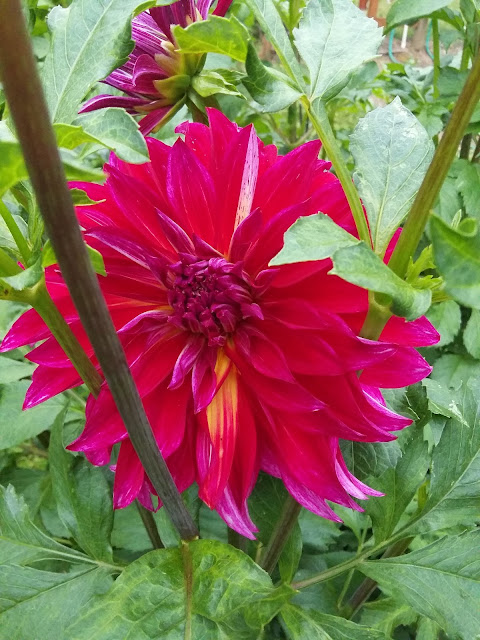Randomness
I've been preparing for a trip this weekend, setting up a fog system in the greenhouse (I suppose I should do a little post on that sometime) and moving plants to shadier spots so they won't dry out as fast, even with an aunt coming to water while we're away. While I've been running around fretting over the thought of leaving my potted plants for several days, I've managed to stop ad appreciate a few of the sights in the garden.
In the greenhouse, another of my vireyas is blooming just as 'Littlest Angel' (you can see it here, if you don't mind scrolling through a long post) is fading. This is one I've raised from a tiny seedling that was sent to me as a bonus plant, having been found in the pot of a Rhododendron wentianum. Not having found much information on that species, I'm not sure if this seedling looks anything like it, or not.
I often say that I'm not particularly fond of yellow, but this is one of those frequent exceptions. Dark yellows like this aren't a common color in hardy rhododendrons, although they're much more common in the tropical vireya rhododendrons like this one. It's a shame they don't seem to be compatible for hybridizing.
Penstemon heterophyllus 'Electric Blue' flops over a bit to say hello to a 'Mikado' California poppy.
I'll have to get my real camera out to see if I can improve on this phone snapshot. It just doesn't give the same perspective as my eye sees in this combination of 'Mikado' California poppy and Trachelium caeruleum 'Hamer Pandora'. The dark stems and leaves of the Trachelium look absolutely stunning with the pale poppy foliage, and I always love purple and orange flowers.
I thought all the gladiolus were gone I dug out most of them because the deer would eat the flowers), but this one just won't give up. It does look nice with the spotted leaves of the calla lily below.
But...it's just so...ruffled...
Moving on to the vegetable garden, which we've been pretty lax with this year. This is why you don't let strawberry spinach (Chenopodium capitatum) go to seed. Oh my. Ninety-nine percent of the strawberry spinach has been removed, and I don't think we'll let them set seed this year. We just found one sprouting in the gravel path off the southwest corner of the house, several hundred feet from the vegetable garden.
The Salvia officinalis that I grew from seed has grown massive in the rich soil of the raised beds. I'm going to dig them out this fall, try to separate them, and plant them in the area I'm preparing across the dry creekbed from the house.
Also massive, the dahlias that I forgot to harvest last fall. Oops. I planted them with the intent of sampling the tubers for their edibility. I guess I'll have to try to remember that this year. They just take up too much real estate in the vegetable garden.
But it has been interesting seeing what came out of the mixed box of tubers I got last year.
This one, besides being up to 8 inches in diameter, is an interesting mix of raspberry with warm undertones and random highlights of orange and white speckled with raspberry.
The most exciting area of the vegetable garden to me is this dense jumble of three different Incan root vegetables. The big leaves belong to Smallanthus sonchifolius, known by the common name yacon. The smaller clover-like leaves below that belong to Oxalis tuberosa, or oca. Growing up the tepee in the middle of that huge mass of oca is Tropaeolum tuberosum, known in the Andes as mashua. You may be familiar with it as an ornamental, particularly the cultivar 'Ken Aslet, selected for its earlier blooming. I'll go into more detail about each of these in a later post. I'm waiting until harvest so I can actually share my impressions of how they taste!
Actually, I did grow oca last year, and found I preferred the crisp, lemony flavor of the raw tubers to the vinegary flavor of the roasted tubers. Though, that may be because we overcooked them. Here's a tip: don't cook potatoes and oca in the same pan. Oca cooks much faster. Anyway, the oca is doing something new this year: blooming!

















I'd love to see a post from you about setting up a fog system. I need to figure out a away to keep cuttings in the greenhouse humid without being soggy. I suppose I could set them on a bed of gravel like many do with orchids. But a misting system might be good too. Loved the pretty pictures of your Dahlias, even if you did just plant them as edibles.
ReplyDeleteI'm going to either tweak my current fog system for cuttings, or get a few more emitters to make a second setup for cuttings. I didn't take pictures while I was doing this first setup but I'll make sure I do it for the next! Without a mist system, I always keep my cuttings with a clear plastic bag or container over the pot to keep up humidity, except in the winter when the whole greenhouse is ridiculously humid.
DeleteI can see why you're a bit nervous about leaving your charges - the garden looks great! I didn't know dahlia tubers are edible so I'll be interested to hear your impressions when you dig them up. In the meantime, I'm impressed by the healthy blooms on your unnamed varieties. As to the tropical rhododendron, those blooms may just convince me to try growing one.
ReplyDeleteBest wishes for an enjoyable trip!
Thanks, Kris! It was a great trip and resulted in many many photos to share.
Delete